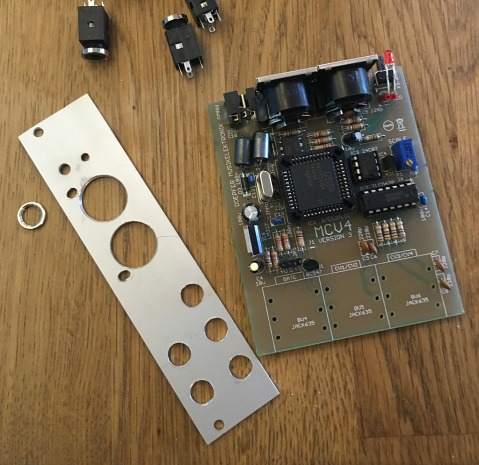ProtoTypo PT7 – CMY
Here’s a small mod for Fonitronik Cascade, a 4HP eurorack module that allows mixing, attenuating / inverting and offsetting of three separate input signals (later “channels” or “ch.”). I totally love it for the size, features and price.
The mod brings on-board jumper terminal JP1 to front panel, so that the signal routing behavior of Cascade can be changed without removing the module from eurorack case.

Fonitronik Cascade, JP1 (with blue jumper) next to the board interconnect. Photo by Thonk.
Eurorack Monster Base, the build
If you found this post via a web search by all means do check out my previous post about the design of this build. You know, to give more context to all the hands-on, wing-it-as-you-go build stuff that’s about to follow!
This build is a Doepfer Monster Base inspired large eurorack case with a few bays for 1U 19″ rack modules! I’ll start with.. Read More…
ProtoTypo PT6 – MCV4E
ProtoTypo PT6 is a straightforward conversion build of a Doepfer MCV4 into a eurorack module. I just removed the circuit board from original case, made a matching eurorack panel and gave that some fffuuuugly artwork! Not much to the build so I figured maybe I’ll just run through my magnificent paper sticker panel artwork method \:D/
ProtoTypo PT5 – BUD666
While working on my ProtoTypo PT3 build I came to realize that actually just about any piece of Behringer audio gear would likely make a pretty neat candidate for hacking. I suppose that Behringer brands mostly as sort of entry-level hardware for the budget conscious. That is, anyone looking to get into audio production will often choose the least expensive entry point and grow up from there.
This reflects on Behringer resale value too, as people looking to “step up” want to off-load their (older generation) hardware to a market that’s constantly flooded by Behringer with the next generation gear (often carrying similar price tag with older gen). Why this is great for hacking is, it puts a ton of ‘source materials’ up for grabs at a very low price. Hacking a second-hand Behringer, say, to even see if it works usually doesn’t set you back much.. Even if you end up destroying the device in the process. Just remember to sort & recycle proper!
Take something like the 5€ DJ mixer (VMX100) that I hacked PT3 from: You’d be happy to get even half of new knobs for the same price (VMX100 has 13), add to that everything else like jacks, PSU etc! Looking at it from the electronics side, say, a basic opamp summing mixer is a basic opamp summing mixer regardless of whether it rolls off a Behringer or Focusrite production line. Using a basic functional block like this in a some other context then simply boils down to identifying it with the help of schematics or a some reverse-engineering.
Anyway TL;DR, I’m almost getting carried away so let’s cut to the chase!
Some months ago I spotted this second-hand Behringer HM300 guitar distortion pedal selling for 15€. I couldn’t help thinking “Well that’s a bargain, wonder if this would make a neat Eurorack module?”, and bought the pedal just to have a look. And so we end up with this build post!
I give you ProtoTypo PT5 aka BUD666 aka BUdget Distortion 666 :D
Why the 666? Well although I didn’t end up adding any extra features to the electronics, I still figured my hack has to be at least 2.22 times better than HM300!
ProtoTypo PT4 – Pairs
While working on my Monster Base (eurorack) case the thought occurred that maybe it would be nice to have some buses to route signals internally from one end of the case to the other, instead of running long patch cables (which can get messy in no time). And that’s this build, the ProtoTypo PT4 (models A and B) in all it’s simplicity.
For the panel artwork, the boring version would’ve been to use matching numbers on both panels. However I like my modular setup colorful, so I finished up the build with a twist on the Find The Pair / Memory game. Each of the bus pairs have similar images to label them:






Recent Comments